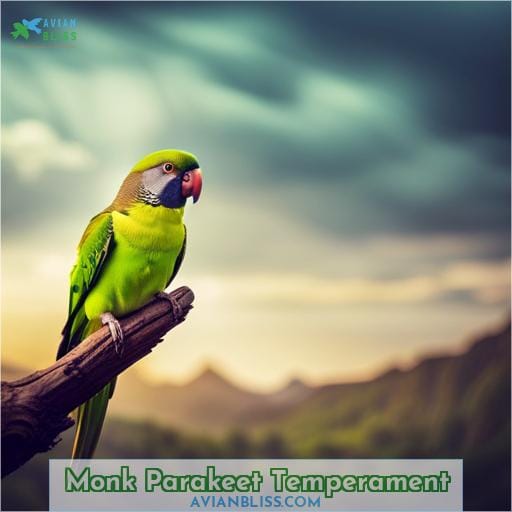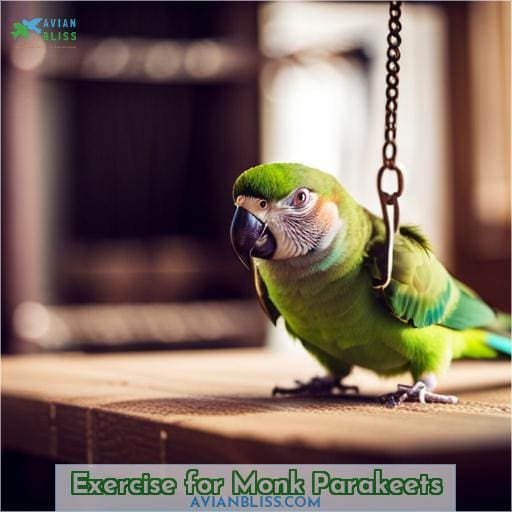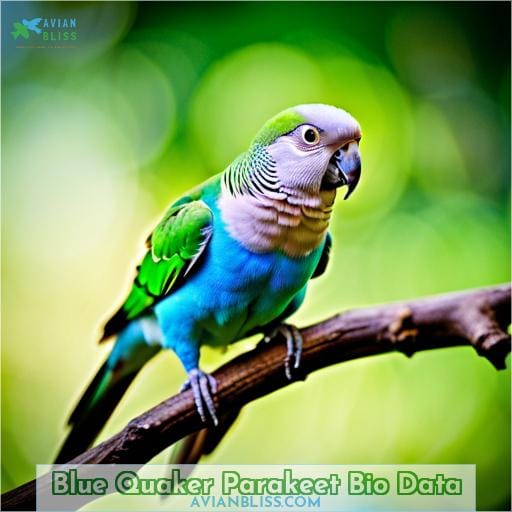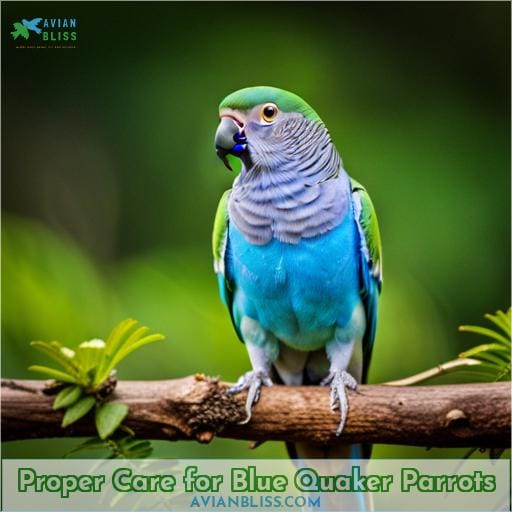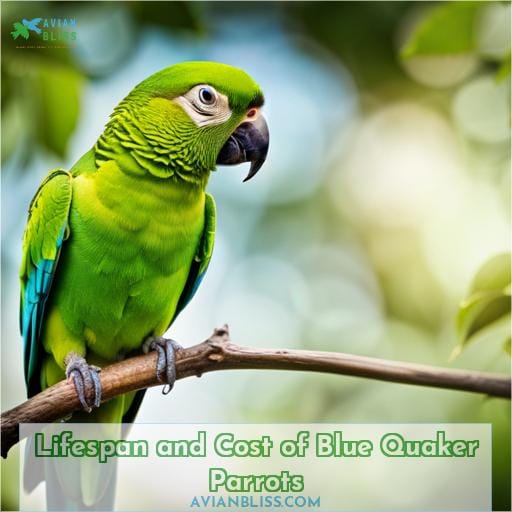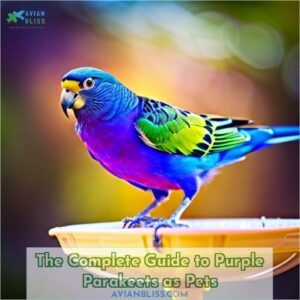This site is supported by our readers. We may earn a commission, at no cost to you, if you purchase through links.
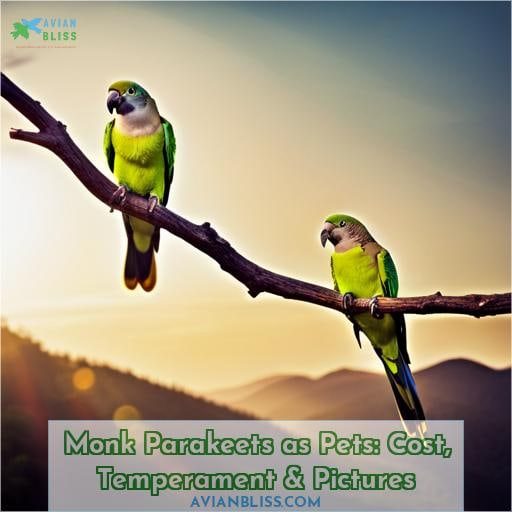 Imagine having a vibrant and talkative companion that brings joy to your home. Monk parakeets, also known as Quaker parrots, are the perfect addition to any bird lover’s life. Not only do they have stunning feathers and playful personalities, but they are also incredibly affordable compared to other talking birds on the market.
Imagine having a vibrant and talkative companion that brings joy to your home. Monk parakeets, also known as Quaker parrots, are the perfect addition to any bird lover’s life. Not only do they have stunning feathers and playful personalities, but they are also incredibly affordable compared to other talking birds on the market.
In this article, we will explore the cost of owning a monk parakeet, their temperament as pets, and provide you with captivating pictures that showcase their beauty.
Get ready to be captivated by these charming avian companions!
Table Of Contents
- Key Takeaways
- Cost to Buy Monk Parakeets
- Monk Parakeet Temperament
- Common Health Problems
- Diet and Nutrition for Monk Parakeets
- Exercise for Monk Parakeets
- Where to Adopt or Buy Monk Parakeets
- Blue Quaker Parrot Aliases
- Blue Quaker Parakeet Bio Data
- Proper Care for Blue Quaker Parrots
- Lifespan and Cost of Blue Quaker Parrots
- Frequently Asked Questions (FAQs)
- Are monk parakeets legal to own as pets in all states?
- Can monk parakeets be trained to do tricks?
- How much does it cost to maintain a monk parakeet, including food and veterinary care?
- Do monk parakeets need a lot of social interaction and attention from their owners?
- What are some common behavioral issues or challenges that monk parakeet owners may face?
- Conclusion
Key Takeaways
- Monk parakeets have a docile and tame temperament, making them suitable as pets.
- The cost of owning a monk parakeet includes the initial purchase, cage, food, toys, and vet visits.
- Common health problems in monk parakeets include respiratory infections, feather mites, and nutritional deficiencies.
- Monk parakeets require a varied diet consisting of seeds, fruits, vegetables, and pellets.
Cost to Buy Monk Parakeets
When considering owning a Monk Parakeet as a pet, you may be curious about the cost of purchasing one.
The price of a monk parakeet can vary depending on factors such as breeder reputation, age, and color variations. On average, you can expect to pay around $600-700 for a monk parakeet. However, it’s important to note that this is just the initial cost and there are other expenses to consider.
One major expense is the cost of providing an appropriate cage for your monk parakeet. A suitable cage should provide enough space for them to fly and move comfortably.
Another ongoing expense is food. A balanced diet consisting of high-quality pellets supplemented with fresh vegetables, fruits, seeds/nuts would need an estimated budget allocation starting at around $40 per month.
Toys are also important in keeping your pet entertained and mentally stimulated – they prevent boredom which could lead to behavioral problems like feather plucking or aggression towards humans/other birds; these toys usually start at $50 in stores but prices will depend on their material quality (some cheaper options mightn’t last long).
Vet visits are necessary throughout your bird’s life since regular check-ups help identify any potential health issues early-on before they become serious matters requiring expensive treatments; vet visits typically range between 50-$100 each visit.
Training costs will also vary depending upon whether you choose private lessons with trainers who specialize specifically in working alongside avian companions versus group classes offered by local organizations – good training sessions might set owners back anywhere between 75-$200/hourly session while monthly membership rates begin near 150$/month.
In conclusion: Owning Monk Parakeets comes along with its own share when we talk financial aspect , so being prepared beforehand seems essential if someone decides they want this species because without proper planning ahead individuals risk finding themselves overwhelmed by these unexpected expenses.
Monk Parakeet Temperament
Monk parakeets have a docile and tame temperament, making them suitable pets for those seeking an interactive bird companion.
They’re known to be social birds that enjoy spending time with their human family members.
Additionally, monk parakeets are highly intelligent and can learn tricks and human words, adding another layer of entertainment to their already active nature.
Species Overview
If you’re considering a Monk Parakeet as a pet, you’ll want to know that they’ve a lifespan of 20-30 years. They’re excellent talkers, measuring 11-12 inches long and require a varied diet.
Origin and History
To understand the temperament of Monk Parakeets, it’s important to delve into their origin and history.
Native to South America, they were introduced to the United States and now live in suburban and urban areas.
They’re considered an invasive species and are banned in 10 US states.
Speech & Vocalizations
Monk parakeets are known for their impressive speech and vocalizations.
They’ve a wide range of vocabulary and can learn a large number of sounds.
Their learning rate, pitch variation, and mimicry ability contribute to their talking ability, making them fascinating pets.
Colors and Markings
When considering the temperament of a Monk Parakeet, one aspect to note is their vibrant colors and unique markings.
They come in various shades of green, blue, yellow, and red with different wing and tail markings.
Their beak color ranges from black to off-white or pinkish-gray.
Caring for Monk Parakeets
Taking care of a Monk Parakeet involves:
- Providing proper nutrition
- Social interaction
- Mental stimulation
- Training
Their cage should be:
- Spacious enough for exercise
- Filled with toys for enrichment
Breeding, health issues, diet, exercise needs to be considered as well.
Common Health Problems
If you’re considering getting a monk parakeet as a pet, it’s important to be aware of the common health problems that may arise.
- Respiratory infections: Monk parakeets can be prone to respiratory infections, which can cause symptoms like sneezing, coughing, and difficulty breathing.
- Feather mites: These tiny parasites can infest the feathers of monk parakeets and cause itching and feather loss if left untreated.
- Psittacosis: Also known as avian chlamydiosis, this bacterial infection can affect both birds and humans. Symptoms include lethargy, loss of appetite, diarrhea, and respiratory issues.
- Nutritional deficiencies: Improper diet or lack of variety in their food can lead to nutritional deficiencies in monk parakeets. This could result in issues such as weak bones or poor feather quality.
It’s important to provide your monk parakeet with proper care including:
- Regular vet check-ups
- A balanced diet consisting mainly of pellets supplemented with fresh fruits, vegetables, nuts, and seeds
- A clean environment
- Exercise
- Toys
- Social interaction
By being proactive about their health care needs, you’ll help ensure they live a long, happy life by preventing these potential health problems from occurring.
Diet and Nutrition for Monk Parakeets
To ensure the health and well-being of your monk parakeet, it’s important to provide them with a balanced and nutritious diet.
Monk parakeets have specific dietary needs that should be met for optimal health. Their diet should consist of a combination of seeds, fruits, vegetables, and pellets.
Seeds are an essential part of their diet as they provide necessary fats and proteins. Fruits and vegetables offer vitamins, minerals, antioxidants, and fiber that contribute to overall wellness.
When selecting seeds for your monk parakeet’s diet, choose high-quality options such as millet or sunflower seeds. Pellets can also be incorporated into their daily meals to ensure they receive all the necessary nutrients in a concentrated form.
In addition to these staples foods, offer fresh fruits like apples or blueberries and leafy greens such as spinach or kale.
It is important to remember that while variety is key, a healthy balance must be maintained to avoid overfeeding on certain food groups.
Always make sure fresh water is available at all times for proper hydration.
By providing your monk parakeet with a diverse range of nutritious foods, you can help promote their overall well-being and support their vibrant feathers and energetic personalities.
Exercise for Monk Parakeets
To keep your Monk Parakeet healthy and happy, it’s important to provide regular exercise opportunities.
These intelligent birds are active by nature and need physical stimulation to prevent boredom and maintain their overall well-being.
One way to ensure they get enough exercise is by providing them with toys specifically designed for Monk Parakeets. Toys that encourage climbing, swinging, and chewing can help keep them entertained while also promoting physical activity.
Training Monk Parakeets can also be a great form of mental and physical exercise. Teaching them tricks or simple commands not only helps stimulate their minds but also provides an opportunity for bonding between you and your feathered friend.
In terms of cage size for Monk Parakeets, it’s crucial to provide a spacious enclosure that allows room for movement. A larger cage will give your parrot more space to stretch its wings, climb around on perches, or even engage in short flights within the confines of its home.
Bonding with a monk parakeet through social interaction is another way to promote both mental stimulation as well as emotional wellbeing in these birds. Spending quality time together outside the cage – whether it’s playing games or simply talking softly – helps establish trust between you two while keeping your bird engaged.
When comparing monk parakeets vs cockatiels in terms of exercise needs,since both species are highly active , they require similar levels of playtime out-of-cage activities. However , each individual bird has unique preferences when comes engaging so observing what kind enrichment makes each particular species happier would be ideal.
Where to Adopt or Buy Monk Parakeets
Now that you know about the importance of exercise for monk parakeets, let’s move on to another crucial aspect of owning one: where to adopt or buy these delightful birds.
If you’ve fallen in love with the charming personality and vibrant colors of monk parakeets, you may be wondering how and where to bring one into your home.
When it comes to adopting a monk parakeet, there are several options available.
One popular choice is checking local animal shelters or bird rescues. These organizations often have various types of birds available for adoption at a reasonable cost. Additionally, they can provide valuable information on proper care and offer guidance throughout your journey as a new owner.
If adoption isn’t an option in your area or if you’re specifically looking for certain traits or color variations in a monk parakeet, purchasing from reputable breeders is another avenue worth exploring.
While this option may come with higher costs compared to adoption fees, it allows more control over selecting specific characteristics like color patterns and personalities that align with what you desire.
Whether adopting or buying from breeders,’ ensuring proper care’ should always be prioritized when bringing home any pet bird.’ Monk Parakeets require consistent attention,’ mental stimulation,’ social interaction’, ‘and regular veterinary check-ups’.
Remember that while acquiring these delightful companions brings joy into our lives’, responsible ownership demands adequate commitment.
Next up: common health problems faced by Monk Parakeets
Blue Quaker Parrot Aliases
If you’re interested in learning more about the Blue Quaker Parrot, also known as the Blue Monk Parakeet or Myiopsitta monachus aequatorialis, we’ll explore its unique aliases and characteristics.
- The scientific name for the Blue Quaker Parrot is Myiopsitta monachus.
- Their life span ranges from 20 to 30 years, making them long-lived companions.
- Originally hailing from South America, these parrots have made their way into homes worldwide.
Blue Quaker Parrots are also commonly referred to as quaker parrots or monk parrots due to their distinctive appearance and behavior. They’ve vibrant blue plumage that sets them apart from other types of quakers. With their playful nature and intelligence, they make wonderful pets for those looking for a lifelong feathered friend.
In terms of diet, Blue Quakers enjoy a variety of foods including nuts, seeds, fruits, and vegetables.
Blue Quaker Parakeet Bio Data
When it comes to Blue Quaker Parakeets, also known as Monk Parakeets, there’s plenty of interesting bio data to explore.
These parakeets are scientifically named Myiopsitta monachus and can grow up to 11-12 inches in length.
Known for their talkativeness and various sounds they make, Blue Quaker Parakeets have a colorful appearance with shades of green, blue, yellow, and red on their bodies.
Scientific Information
Let’s delve into the scientific information of Blue Quaker Parakeets, also known as Monk Parrots.
These parakeets have a lifespan of 20-30 years and are native to South America. They belong to the Psittacidae family and are known for their vocalizations and varied diet in the wild.
Size and Appearance
The Blue Quaker Parakeet, also known as the Monk Parakeet, is a small bird measuring between 11 and 12 inches in length.
Talking Ability
Blue Quaker parakeets are known for their impressive vocal skills.
They have a wide vocabulary and can learn words and phrases easily.
They are good mimics, loud talkers, and have a friendly demeanor.
Noise Level
If you’re considering a Blue Quaker Parakeet as a pet, you’ll want to be aware of their noise level.
These parakeets can be quite noisy, with high-pitched vocalizations that can be disruptive at times.
They’ve the ability to talk a lot and make themselves heard.
Personality and Behavior
When considering a Blue Quaker Parakeet as a pet, you’ll find that their personality and behavior make them an engaging and lively companion.
- Playful: Blue Quaker Parakeets love to engage in various activities such as playing with toys and exploring their surroundings.
- Intelligent: These parakeets are known for their ability to learn tricks and even mimic human speech.
- Territorial: Blue Quakers can be protective of their space and may display territorial behaviors towards other birds or animals.
- Noisy: Like most parrots, these vibrant birds can be quite vocal with loud squawks and calls throughout the day.
Proper Care for Blue Quaker Parrots
When it comes to proper care for Blue Quaker Parrots, there are several key points to keep in mind.
First and foremost is providing them with appropriate housing, which should be spacious enough for them to move around comfortably.
In terms of diet, a balanced mix of high-quality pellets, fresh fruits and vegetables, nuts and seeds is essential.
Maintaining good hygiene through regular cleaning of their cage and providing access to fresh water is also crucial.
Lastly, if you’re considering breeding your Blue Quaker Parrot, make sure you have the necessary knowledge and resources beforehand.
Housing
To properly care for your Blue Quaker Parrot, you’ll need to provide suitable housing.
The ideal cage size for a Blue Quaker Parrot is at least 24 inches in height and width.
Ensure that the cage bars are spaced appropriately to prevent escape, and choose a durable material like stainless steel or powder-coated metal.
Diet
To properly care for Blue Quaker Parrots, you should provide them with a balanced and nutritious diet.
Their diet should include a variety of healthy and natural foods such as fruits, vegetables, seeds, and nuts to ensure they receive proper nutrition.
A balanced diet is crucial for their overall health and well-being.
Hygiene
To maintain proper hygiene for your Blue Quaker Parrot, regularly clean its cage and provide fresh water daily.
Bathing plays an important role in keeping a blue quaker parrot’s plumage clean and vibrant:
- Bathing Frequency: It’s recommended to offer regular baths at least once or twice a week depending on their preference and needs.
- Water Temperature: When preparing bathwater, make sure it’s lukewarm (not too hot or cold).
- Bathing Time: Allow enough time for the blue quaker parrot to enjoy their bath experience fully without feeling rushed – typically a few minutes per session should suffice unless they show signs of wanting more prolonged periods of splashing around!
- Bathing Products: While some birds may be content with plain water showers from misters or shallow dishes placed inside their cages; others might benefit from using mild avian shampoos specifically designed not only cleanse but also promote healthier feather growth! These products are available at most pet stores specializing in avian supplies.
Regular bathing not only helps maintain proper hygiene but also offers several benefits to your Blue Quaker Parrot.
- Remove dirt and debris from their feathers, keeping them clean and free of parasites.
- Moisturize their skin and feathers, preventing dryness or irritation.
- Cool down during hot weather or regulate body temperature in general.
- Engage in a natural behavior that mimics how they’d bathe in the wild.
By following these guidelines for bathing your Blue Quaker Parrot, you can ensure its hygiene needs are met while providing an enjoyable experience for your feathered friend.
Breeding
When breeding Blue Quaker Parrots, ensure proper care for a healthy and successful process.
The incubation period is around 28 days, with clutch sizes ranging from 4 to 8 eggs.
Provide a nest box measuring 12 x 12 x 24 inches during the spring and summer breeding season.
Hand-rearing is possible but difficult.
Lifespan and Cost of Blue Quaker Parrots
If you’re considering getting a Blue Quaker Parrot as a pet, it’s important to understand their lifespan and the cost associated with owning one.
Blue Quaker Parrots have an average life expectancy of 20-30 years, with some individuals living even longer. This means that they can be long-term companions for those willing to commit to their care.
In terms of cost, Blue Quakers are generally priced between $600 and $700 on average. However, it’s essential to consider additional expenses such as cages ($30-100), food ($40), and toys ($50). The total cost of owning a Blue Quaker Parrot can range from $800-$900 or more when factoring in these extra items.
Aside from lifespan and cost considerations, another important aspect is trainability. Fortunately, Blue Quakers are known for their excellent trainability. They possess high intelligence levels which make them quick learners when it comes to tricks or mimicry.
In terms of noise level moderation: While all parrots have the potential for vocalizations at varying volumes throughout the day; overall noise level produced by quakers is considered moderate compared other bird species.
When it comes diet: A varied diet is crucial for proper health maintenance in blue quaker parrots just like any other avian pets!
Frequently Asked Questions (FAQs)
Are monk parakeets legal to own as pets in all states?
Yes, monk parakeets are legal to own as pets in most states.
However, there are 10 states where they’re banned due to their classification as an invasive species.
It’s important to check local laws before getting a monk parakeet as a pet.
Can monk parakeets be trained to do tricks?
Yes, monk parakeets can be trained to do tricks.
With their intelligence and eagerness to learn, they’re capable of performing a variety of tricks such as:
- Waving
- Retrieving objects
- Even solving puzzles.
How much does it cost to maintain a monk parakeet, including food and veterinary care?
To maintain a monk parakeet, including food and veterinary care, you can expect to spend an average of $800-
This includes the cost of:
- High-quality pellets
- Healthy seed mix
- Fresh fruits and vegetables
- Routine vet visits for check-ups and vaccinations
Do monk parakeets need a lot of social interaction and attention from their owners?
Monk parakeets thrive on social interaction and require attention from their owners.
They enjoy being part of the family and need mental stimulation to prevent boredom.
Regular playtime, training sessions, and socializing are essential for their well-being.
What are some common behavioral issues or challenges that monk parakeet owners may face?
When it comes to owning monk parakeets, some common behavioral challenges you may face include:
- Territorial aggression towards other birds
- Potential noise and vocalization issues
- The need for mental stimulation to combat boredom
Conclusion
To sum up, Monk Parakeets make wonderful pets that are both affordable and entertaining.
With their vibrant feathers and playful personalities, they bring joy and beauty to any home.
They’re known for their ability to talk and mimic sounds, adding an extra level of interaction to their already engaging nature.
If you’re looking for a lively and captivating avian companion, consider adding a Monk Parakeet to your family.


